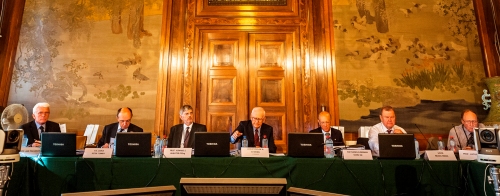The Court of Arbitration (CoA) constituted under the Indus Waters Treaty delivered its Final Award in the Kishenganga Arbitration between Pakistan and India on 20 December 2013. As reported previously, the CoA issued a Partial Award in the matter on 18 February 2013. The Partial Award allowed India to proceed with the construction of its Kishenganga Hydroelectric Power Project (KHEP), subject to ensuring a minimum downstream flow of water to be determined in the Final Award. It also prohibited India from using drawdown flushing for sediment control at the KHEP and any future run-of-river plant on the Western Rivers. (For more information on the Partial Award and the background to the dispute, please see my ASIL Insight on the Partial Award available here and here.)
In its Final Award, the CoA determined the minimum downstream flow of water to be ensured by India. The Parties’ submissions for the second phase of the proceedings included data on the water flow in the Kishenganga river, effect of the minimum flow of water on power generation, agriculture uses in the Neelum valley, and the environmental impact of the KHEP. The CoA described its task in the second phase of the proceedings as follows:
Taken as a whole, the task facing the Court — now having the benefit of significantly more information and analysis from the Parties — is to determine a minimum flow that will mitigate adverse effects to Pakistan’s agricultural and hydro-electric uses throughout the operation of the KHEP, while preserving India’s right to operate the KHEP and maintaining the priority it acquired from having crystallized prior to the NJHEP. At the same time, in fixing this minimum flow, the Court must give due regard, in keeping with Paragraph 29 of Annexure G, to the customary international law requirements of avoiding or mitigating trans-boundary harm and of reconciling economic development with the protection of the environment.
(Final Award, para. 87)
Having considered the Parties’ submissions, the CoA decided that “India shall release a minimum flow of 9 cumecs into the Kishenganga/Neelum River below the KHEP at all times at which the daily average flow in the Kishenganga/Neelum River immediately upstream of the KHEP meets or exceeds 9 cumecs.”
However, it also held that “[a]t any time at which the daily average flow in the Kishenganga/Neelum River immediately upstream of the KHEP is less than 9 cumecs, India shall release 100 percent of the daily average flow immediately upstream of the KHEP into the Kishenganga/Neelum River below the KHEP.” (Final Award, p. 43)
The CoA allowed the Parties to seek a reassessment of the minimum flow through the mechanisms in the Indus Water Treaty 7 years after the diversion of water from the Kishenganga river for power generation at the KHEP. Finally, the CoA noted that the “Final Award imposes no further restrictions on the operation of the KHEP” (Final Award, p. 43)
With respect to India’s request for a clarification, as to whether the CoA’s prohibition on the use of drawdown flushing contained in the Partial Award applied only to the KHEP or to all/any future hydroelectric projects on the “Western Rivers” under the Indus Waters Treaty, the Court issued a separate Decision on 20 December 2013, finding that the prohibition on drawdown flushing is of a “general application”, and is not limited to the KHEP alone.


